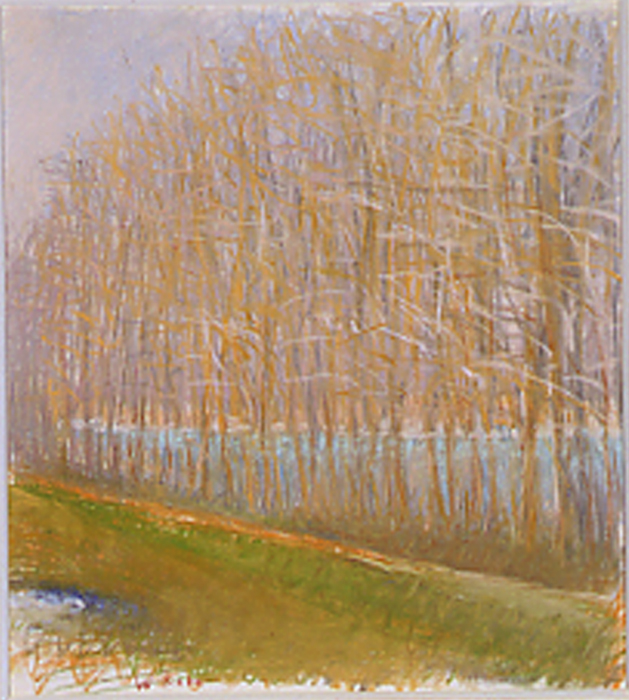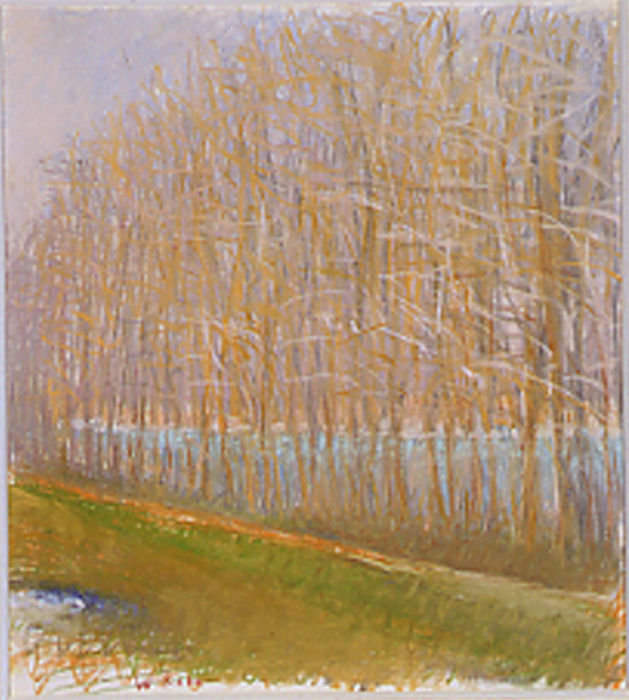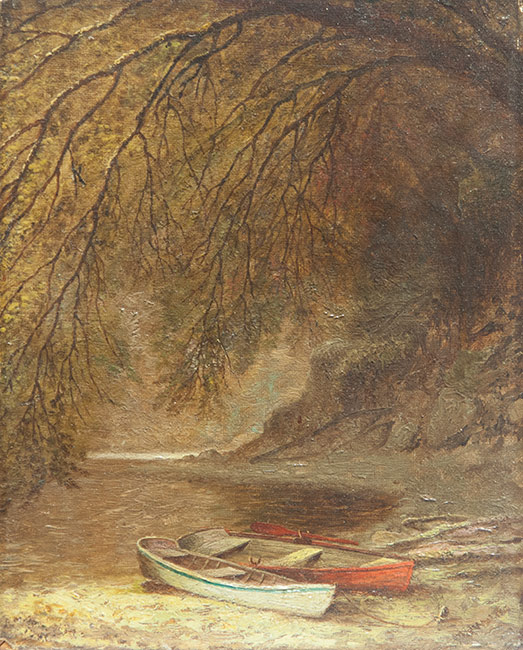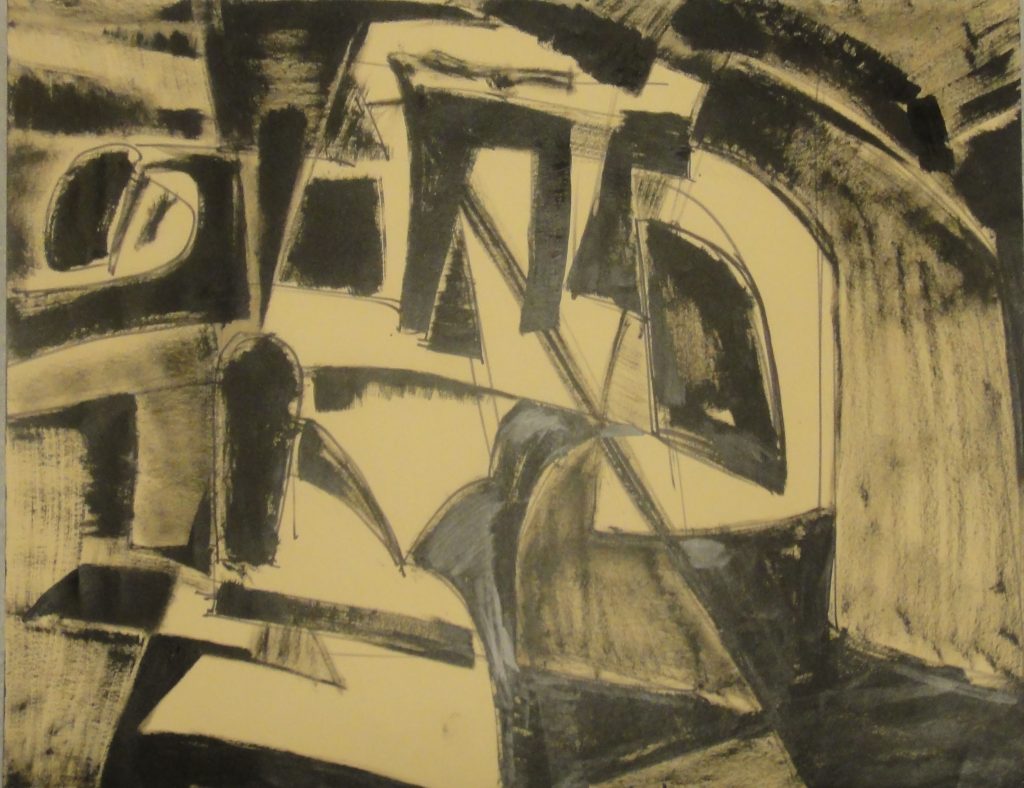Lost (for me at least) amid all the tumult of March, when the first wave of COVID-19-related shutdowns were cascading across the country, was the March 15 death at age 92 of the painter Wolf Kahn. Having just completed my Luce project research on Kahn, I would like to take a few moments to appreciate the career of this remarkable man. Kahn was born in Stuttgart, Germany, and raised in Frankfurt by his wealthy and doting paternal grandmother, also spending a lot of time with his equally devoted maternal grandparents. Though his father—who had lost his job as an orchestra conductor with the rise of the Nazis—had emigrated to the United States with his older siblings and stepmother in 1937, the Kahns, like many other German Jews of the period, did not realize until it was nearly too late the true danger they were in. Young Wolf barely made it out of Germany, part of the famed Kindertransport that saw Jewish children allowed to England to stay with host families. Only when the United States relaxed immigration quotas to allow families to reunite in 1940 did Kahn travel to the United States. His three beloved grandparents were unfortunately not so lucky. They were sent to Theresienstadt in 1942. None of them was ever heard from again.1
Kahn spent his teenage years in Manhattan, where he numbered among his friends fellow future artist Allan Kaprow. It was his decision—after a year or so in the Navy—to use his GI Bill funds to attend the Hans Hofmann School of Art, however, that set him on the course that would define his life.2 Way back in April I wrote about Tibor Pataky, a Hungarian-born artist whose study with Hofmann on Cape Cod during the summers of 1952 to 1957 caused him to abandon realism in favor of a fully abstract style.3 In one of those great bits of research serendipity, I was delighted to discover that Kahn was also on the Cape during the summers of 1953 and 1954, when he returned not to study with Hofmann but rather to work on his art and take part in the congenial social life surrounding the German teacher.4 I have not come across any mention of the two men meeting, though it is hard to believe that they would not have crossed paths, perhaps at one of Hofmann’s legendary criticism sessions. In any case, this bit of historical circumstance invites us to consider the influence of Hofmann once again. If Pataky is an example (one of many) of a painter completely changing his technique under Hofmann’s influence, Kahn is something different. Kahn—whose successful career saw him still an active artist well into his 80s—successfully adopted many of Hofmann’s techniques and approaches while never relinquishing his figurative style. In fact, the art historian Barbara Novak has called Kahn’s work a perfect melding of the American landscape tradition with the Hofmann-influenced Abstract Expressionism that dominated the art world during his formative years.5

Right / Tibor Pataky (American, born Hungary 1901-1978), Abstract Study (detail), Charcoal on paper, 18 x 23 3/4 in., Gift of Mrs. Tibor Pataky, 1985.31.27
Like another American master of the pastel, Childe Hassam, Kahn loved to paint and draw riverside scenes. He was particularly drawn to the Connecticut River, near his country home in North Brattleboro, Vermont, but he also sought out other rivers on his travels around the country.6 This places Kahn squarely in the American landscape tradition, in which waterways always played a key role. Kahn’s pastel Trees Along the Delaware dates from his mature period, when he had established the brightly colored landscape aesthetic which occupied him from the late 1960s to the 2010s. Kahn’s favorite season for painting was the fall, which is reflected in the bareness of the trees that line the river’s banks.7 In this the work reminds me of Two Boats by Hudson River School painter Mary Josephine Walters, which takes a similar perspective on a river, perhaps the Hudson upstate of New York City. Yet there is an obvious difference, as well: while Walters uses colors taken from life, Kahn renders the titular trees in his signature bright orange, framing them in a hazy bluish-purple, another favorite color.8 There is also another difference, a subtler one that is highlighted by comparison to one of the studies Pataky executed while under Hofmann’s tutelage in the 1950s. Hofmann was famous for requiring his students to draw their subjects not as objects, but rather as forms which stand in dynamic relation to the forms of the space around them.9 Trees Along the Delaware represents Kahn’s careful merging of the traditions represented by Walters and Pataky, with more than a little of the bravura line and devotion to bright acrylic color of Abstract Expressionists like Willem de Kooning. His trees are recognizable as trees, but they are also a mass built up of solid forms, forms that stand in dynamic tension with the acid yellow green of the foreground and the cool blue of the river itself. This work is all the more remarkable in that it was made in the late twentieth century when figurative art and painting had ceased to dominate the art world conversation.
1 Justin Spring, “Wolf Kahn and His Art,” in Wolf Kahn, Updated ed., 2nd ed (New York: Abrams, 2011), 9–12.
2 Spring, 13–17.
3 Bishop, Phillip E. “The Paintings of Tibor Pataky.” The Orlando Sentinel, July 22, 2001.
4 Spring, “Wolf Kahn and His Art,” 29–32.
5 Barbara Novak, “Introduction,” in Wolf Kahn Pastels (New York: Harry N. Abrams, 2000), 7.
6 Wolf Kahn, Wolf Kahn Pastels (New York: Harry N. Abrams, 2000), 116.
7 Kahn, 103.
8 Kahn, 103. Spring, “Wolf Kahn and His Art,” 59.
9 Spring, “Wolf Kahn and His Art,” 16–17.






0 comments on “Pausing to Appreciate Wolf Kahn”
1 Pings/Trackbacks for "Pausing to Appreciate Wolf Kahn"
[…] the last entry of this blog, I wrote about the American painter Wolf Kahn, whom the art historian Barbara Novak regarded as perfectly blending the American landscape […]